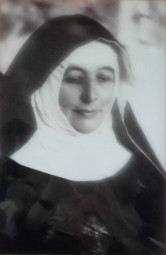|
History
of the Abbey and Community
Burnham
Abbey
Burnham
Abbey was founded for a community of Augustinian Canonesses in 1266
by Richard, Earl of Cornwall, brother of King Henry III, reputedly
in thanksgiving for his release from captivity after the Battle of
Lewes in 1265.
The
Abbey was built around a cloister garth, with a frater, church,
guest house, kitchen and two storey quarters for the nuns. The
infirmary was a separate building connected by a passage
to the east range.
It
continued to operate until it was suppressed at the Reformation and
the Abbess and nine nuns, who formed the community in 1539,
dispersed.
After
the dissolution, the Abbey was leased to William Tyldesley and
subsequently came into the possession of the Wentworth family. The
church was demolished and a private house formed from much of the
remaining buildings. In due course it became a farm and
the buildings gradually fell into disrepair.
In 1913 it was purchased by James Lawrence Bissley, an architect and
surveyor, who restored the remaining buildings and converted the
original pre-reformation chapter house into a chapel.
In
1916 James Bissley sold the property to the
Society of the Precious Blood who, in 1952, enlarged the chapel
without spoiling its simplicity.
There
is still a piece of the north wall of the ancient church in the
present refectory.
Most of the east range still has medieval walls. Further sections of
the original abbey are in the Sisters' garden.
Grade
1 listed, Burnham Abbey is one of the best surviving medieval
religious houses in Buckinghamshire.
Click
to enlarge pictures
Further images here
courtesy of Thames Pilot.
The Community
"The
reason you have come together is that you may have one heart and one
mind entirely centred upon God".
So wrote St Augustine, in the 5th century, to a group of
Christians who had come together for just that reason.
Down the centuries God has called
some people to come aside, away from the business of the world, to
worship Him and to seek
Him in spirit and truth - a truth which
gradually opens our hearts to embrace the needs of the whole world
in prayer. It is good to have companions on the way and that is what
a Christian Community is: a group of friends travelling on the
spiritual journey together. As the group expands so the need is felt
for some sort of structure to hold it together and that is why St
Augustine wrote the letter which has become known as the Rule of St
Augustine.
The
Society of the Precious Blood (SPB) began as an active Community. It
dates from 1905 when
Mother Millicent Mary SPB (formerly Millicent Taylor) took vows in
the parish of St Jude,
Birmingham.
|

|
|
Mother Millicent |
The
Community which formed around her adopted the early monastic Rule of
St Augustine on which to base its spirituality and chose as its motto
the words o f St Paul “I will most gladly spend and be spent for your
souls’ sake”. At their abode in a house in Birmingham they lived a strenuous and extremely penitential life. The Sisters
were in direct contact with the outer world, involving daily parish
visiting, Sunday school teaching and the running every night of a
factory girls’ club.
SPB
grew and from late 1908 began to be drawn to a stricter life of
prayer. On St Luke’s Day 1909 the Community migrated from the
slums of central
Birmingham
to an old farm house in the parish of King’s Heath, south of
Birmingham, where poverty and hardship were endured, greater than
ever faced before.
In
1914 the Community moved to Hendon, increased in numbers and
felt more and more drawn to deeper prayer and less active
involvement outside the Community. Burnham Abbey happened to be
on the market so Mother Millicent went to have a look at it and, in
her words, “We came, we saw and it conquered! I shall never forget
the welcome the place gave us and the irresistible atmosphere of
calm quiet peace that surrounded it”.
The Community
moved to Burnham Abbey in 1916, 650 years after the first dedication
of the Abbey, at last becoming a fully Contemplative Community.
|
For
a fuller account of the history of SPB, a publication
entitled "Mother Millicent" is available from
the Community. |
 |
|